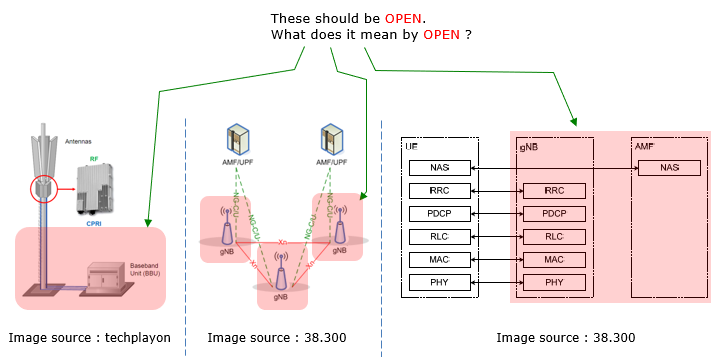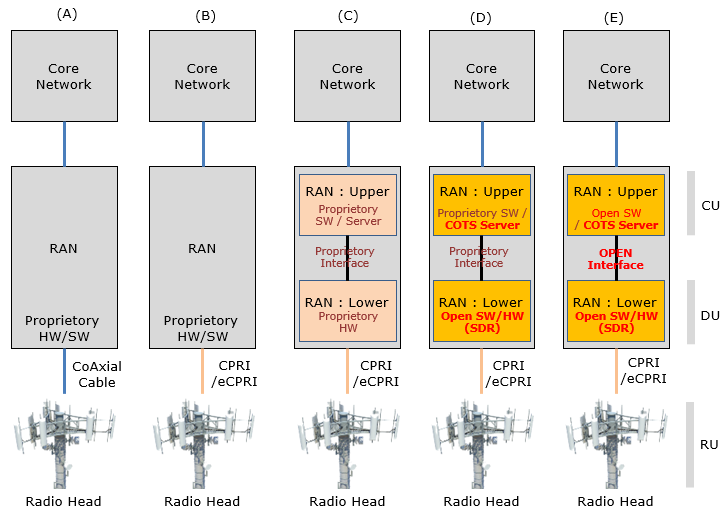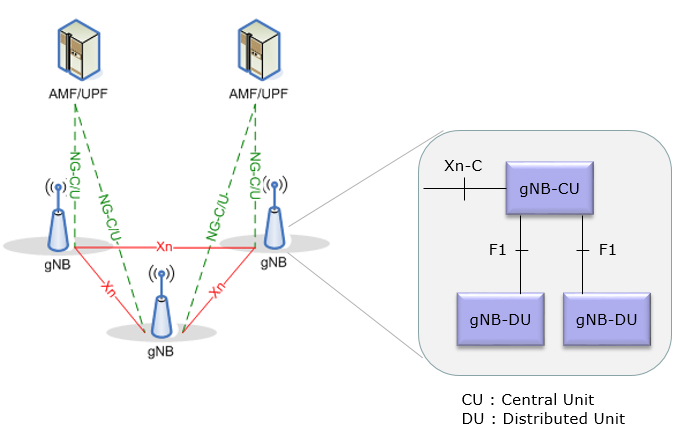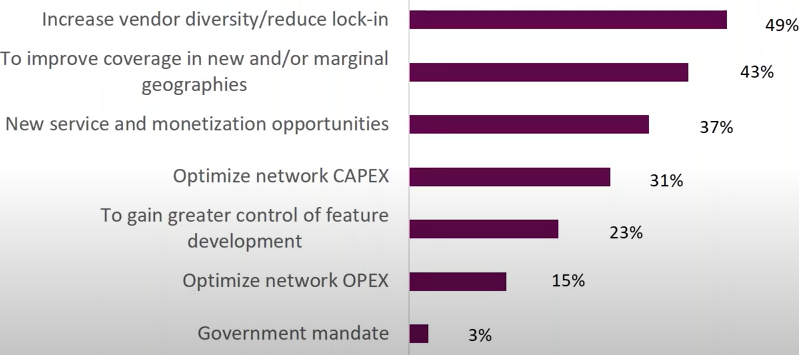|
You might have been hearing about Open RAN for many years (as of Jan 2022). It has been a buzz word especially in 2019, 2020, 2021 and it is likely to see more and more cases of Open RAN-based deployment in coming years.
What is OpenRAN ? There are many different definition and the scope of definition keep changing and expanding, so it gets more and more difficult to clearly define it. I just want to define it by sticking to the literal meaning of the name. Literally OpenRAN mean 'Open' the 'RAN(Radio Access Network)'. If you know what RAN is, OpenRAN can be illustrated as below. The issue is to
figure out the meaning of 'OPEN' in this context.

The meaning of 'OPEN' in this context can be summarized by a few keywords as listed below.
- Virtualization of RAN components ==> Implementing the components in software
- COTS(Commercial Off-The-Shelf) hardware
OpenRAN is not a thing that is invented overnight. It is the result of gradual evolution of the RAN architecture. This RAN evolution process can be summarized in illustration as shown below. The architecture shown at stage (E) is what we call OpenRAN.

In the illustration shown above, I used the term 'RAN : Upper' and 'RAN : Lower'. There are many options to split RAN protocol stack into two parts. By 'RAN Upper', I meant the higher layer of RAN protocol stack and by 'RAN Lower' I mean the lower layer of RAN protocol stack. One example of this kind of split is CU-DU split which is defined in 3GPP NR specification which can be illustrated
below. The RAN Upper corresponds to CU and RAN Lower corresponds to DU (NOTE : Check this page for the details of CU-DU separation)

I think a few keywords for OpenRAN are 'OpenInterface' and 'COTS' hardware. I think as long as a system can provides all the open interface as specified in industry standards and that can be implemented / supported by general purpose hardwares, I don't think it should be done all in the software. Theoretically, every components except ADC/DAC and Antenna can be implemented purely by software.
Some of the SDR solutions already implements all the components except ADC/DAC and Antenna purely by software. Even though software only solution is not mandatory for OpenRAN, it looks pretty obvious that OpenRAN solution would adopt much more components in software solution comparing to legacy implementation/deployment.
What is the motivation for OpenRAN ? The answer would vary depending on who you ask. One example list of the motivation is as shown below. To me, this seems to be more with respect to business side. There would be different list of motivation with focus on technical aspect as well.
I think the ranking for items in the list may also vary depending on who you ask to and when you survey, but the list itself well captured the most of the reasons / motivations for Open RAN.

Source : Open RAN and 5G: Deployment Options and Key Issues for Operators
Followings are list of advantages that industry claims. There might be some you would agree on but some you don't agree with. I am just trying to list as many aspect as possible for brainstorming purpose.
- Cost savings: OpenRAN can reduce the cost of building and maintaining wireless networks, as it allows operators to use hardware and software from multiple vendors, which can increase competition and reduce prices.
- I think this should be the most important driving force for OpenRAN industry. At first I automatically thought that OpenRAN would cost less than the conventional deployment. However, after some chats with industry players (as of late 2022) I learned that the situation is not as simple as I thought. It seems that the conventional deployment has been very mature
and optimized a lot in terms of cost issues but the components of OpenRAN is not as cost effective as claimed. For example, mainly due to performance issue, we need to use very high quality network equipments in the openRAN deployment and the cost of those components is even higher than the counter part component in conventional deployment.
- Increased innovation: By allowing different vendors to provide components for the network, OpenRAN can encourage innovation and new technologies in the industry.
- Greater flexibility: OpenRAN can allow operators to customize their networks and adapt to changing technologies and user demands more easily.
- Better security: OpenRAN can potentially improve security by enabling operators to choose the best security technologies from different vendors and integrate them into their networks.
- Reduced vendor lock-in: In traditional RAN deployments, operators are often locked into using hardware and software from a single vendor. This can make it difficult to switch vendors or make changes to the network. OpenRAN, on the other hand, allows operators to use components from different vendors,
which can reduce the risk of vendor lock-in.
- Increased competition: OpenRAN can increase competition in the industry by allowing new vendors to enter the market and offer innovative solutions. This can lead to more choice for operators and potentially lower prices for consumers.
- Support for new technologies: OpenRAN can help to support new technologies and standards, such as 5G and virtualization. By enabling operators to mix and match components from different vendors, OpenRAN can facilitate the deployment of these new technologies and accelerate their adoption.
- Support for rural and remote areas: OpenRAN can be particularly beneficial for operators serving rural and remote areas. By using low-cost, standardized hardware and software, OpenRAN can enable operators to deploy wireless networks in areas where traditional RAN solutions may be too expensive
or difficult to implement.
- Open standards: OpenRAN is based on open standards, which can help to ensure interoperability between different components and reduce the risk of vendor lock-in. This can promote a more diverse and competitive ecosystem for wireless networks.
- Improved network efficiency: OpenRAN can potentially improve network efficiency by allowing operators to optimize their networks using best-of-breed components from different vendors. This can lead to more efficient use of network resources, improved network performance, and better quality of
service for users.
- Simplified network management: OpenRAN can simplify network management by providing a unified, standardized interface for different network components. This can make it easier for operators to manage their networks and reduce the complexity of their operations.
- Scalability: OpenRAN can be easily scaled up or down to meet changing network demands. By using standard hardware and software components, OpenRAN can provide a flexible and scalable solution that can be adapted to meet the needs of different operators.
- Increased collaboration: OpenRAN can encourage collaboration between different players in the industry, including operators, vendors, and software developers. By promoting open standards and interoperability, OpenRAN can create a more collaborative ecosystem for wireless networks, which can lead
to greater innovation and better solutions for users.
- Environmental benefits: OpenRAN can potentially have environmental benefits by reducing the amount of e-waste generated by traditional RAN deployments. By using standardized hardware components that can be easily upgraded or replaced, OpenRAN can reduce the need for costly and environmentally
damaging hardware upgrades.
Even though OpenRAN solution evolves rapidelny and is getting stronger attention, there are some challenges for OpenRAN.
Performance Issue : Whenever you are trying to talke about OpenRAN implementation, one of the most common challenges you would get would be performance issue. But depending on specific use case and deployment type, you may say 'we don't have performance issue any more' or you should say 'we still have
way to go before the openRAN system meets the performance requirement'.
OpenRAN networks may not be able to match the performance or reliability of traditional RAN deployments. For example, using software-based components may introduce latency or other performance issues, which may need to be addressed through careful design and testing
- As of end of 2021, it seems that OpenRAN performance already reaches to the point to support LTE network with relatively small number of frequency support and not much requirement of density like rural area, and we even see the working example like Rakuten. But it is not yet at the point of meeting the performance requirement that are needed for multi carrier aggregation, Massive
MIMO capability (e.g, 5G).
Lack of Common Standard : I think Open RAN specification has been matured greatly, but I don't think it is as mature as or as agreed upon in the industry as 3GPP.
- The development of these standards can be complex and time-consuming, and there may be disagreements between different stakeholders over the direction and scope of the standards
- As of end of 2021, I think OpenRAN specification from O-RAN Allience would be at the leading position in terms of specification but I am not sure if it is the only specification that every players are following like 3GPP. For Fronthaual specification, it seems most of OpenRAN players tries to support the O-RAN allience specification(7.2x split). I think most of the players
would be likely to agree upon O-RAN allience specification on CU/DU definition and interface since the same specification are adopted by both O-RAN allience and 3GPP. But I am not sure how most of industry players are thinking of other components of OpenRAN architecture.
Interoperability: OpenRAN requires interoperability between components from different vendors, which can be challenging to achieve. There is a risk that different vendors may interpret the standards differently, leading to compatibility issues and delays
in deployment.
Integration: OpenRAN requires integration between different components of the network, including the RAN, the core network, and the management system. Integrating these different components can be complex and time-consuming, particularly when working with components from different vendors.
- Sometimes it is suggested to employ a third party to do this job. It may be a good idea, but this approach would introduce additional cost.
Security: OpenRAN introduces new security risks, as it involves using components from multiple vendors, some of whom may have different security protocols or standards. Ensuring the security of OpenRAN deployments will require careful planning and coordination between vendors and operators.
Cost: While OpenRAN has the potential to reduce costs over the long term, there may be additional costs associated with deploying and integrating components from different vendors. There may also be additional costs associated with training personnel on how to operate and maintain OpenRAN networks.
- This would sound a little bit counter intuitive since 'Reduced Cost' has been mentioned as one of the strongest motivation for OpenRAN. But in reality, openRAN may not be as effective as hoped in terms of cost, at least for the period of eary adoption.
Immaturity: OpenRAN is a relatively new technology and is still in the early stages of development. There is a risk that some components may not be fully mature or may not meet the required standards, leading to delays in deployment or issues with network performance.
Vendor support: In order for OpenRAN to be successful, it requires the support of a broad ecosystem of vendors, including hardware providers, software developers, and systems integrators. If vendors are not willing to invest in developing OpenRAN solutions or if they do not see a viable business case
for it, adoption may be slow.
Regulatory environment: The regulatory environment may pose challenges to the adoption of OpenRAN, particularly in countries where there are strict regulations around network security or vendor selection. Addressing these regulatory issues may require collaboration between vendors, operators, and policymakers.
Legacy systems: Many operators have existing RAN deployments that may not be compatible with OpenRAN. Integrating these legacy systems with OpenRAN may be challenging, and may require additional investment in order to upgrade or replace existing infrastructure.
Followings are a list of mobile service provider who already deployed Open ran based network or known to deploy in near future.
Rakuten Mobile : Japan, In 2019, Rakuten was the first to implement a multi-vendor RAN, using products from Altiostar, Airspan, Nokia and others. Rakutens network began as an LTE network consisting of both macro and small cells. The company has evolved
its network to deploy 5G NR using sub 6 GHz radios from NEC and a container-based solution from Altiostar. See this.
Inland Mobile : US. See this.
DISH Network : US. Dish will begin roll out of the worlds second (after Rakuten) large, greenfield network based entirely on O-RAN technology. With a commitment to cover 70% of the U.S. population by June 2023. See this.
Vodafone : U.K., announced a 2,600-site OpenRAN deployment with a commitment to have 1,150 of these sites live by 2023. See this.
==> According to this video (Jan 2022), Vodafone just powered on one OpenRAN cell site.
1&1 : Germany. See this.
YouTube
- Facebook reveals open source wireless platform, OpenCellular (Jul 2016)
- Vodafone & Telefonica present results of Open RAN RFI at TIP Summit 2018
- Beginners: Open RAN, White Box RAN & vRAN (Feb 2019)
- Mavenir Open RAN Demo from TIP Summit 2019 (Nov 2019)
- Parallel Wireless Open RAN Demo from TIP Summit 2019 (Nov 2019)
- World's First All Virtualized Mobile Network on OpenStack Including vRAN (Dec 2019)
- Open RAN TerminologyUnderstanding the Difference Between Open RAN,OpenRAN,ORAN, and More (Apr 2020)
- An Introduction to the Open RAN Concept (May 2020)
- Why We Need the Open RAN Movement Even Though 3GPP Interfaces Are Open (Jun 2020)
- An Overview of Key Open RAN Groups (Jul 2020)
- Open RAN Integration Challenges (Aug 2020)
- Delivering 5G with OpenRAN & End-to-End Automation - Bejoy Pankajakshan, Mavenir (Sep 2020)
- ETTelecom Interviews: Rakuten CTO Tareq Amin on 5G, OpenRAN, Jio 5G, TechM with Danish Khan (Sep 2020)
- Live Keynote 1 (Part 2): Tareq Amin, Rakuten (Sep 2020)
- Nokia Open RAN Overview - Sandro Tavares, Nokia (Sep 2020)
- Open RAN Panel Session 1 - Mavenir, Nokia, ONF & Parallel Wireless (Sep 2020)
- Open RAN and 5G: Deployment Options and Key Issues for Operators (Nov 2020)
- Building the Ideal 5G Baseband (Jan 2021)
- 5G Transformation Forum: Is OpenRAN set to disrupt the ecosystem completely? (Feb 2021)
- SD-RAN Techinar 2021 (Feb 2021)
- O-RAN Architecture and Use Cases(Feb 2021)
- A Deep Dive into Open RAN (Feb 2021)
- Open RAN - whats the plan for 2021? (Mar 2021)
- Building an OpenRAN DU with Intels FlexRAN (Mar 2021)
- FlexRAN: Enabling OpenRAN Deployments (Mar 2021)
- Startup Innovation in the Open RAN Ecosystem(Apr 2021)
- Rakuten Mobile's Tareq Amin on 5G and Open RAN (Jun 2021)
- How DISH Networks is Building the Worlds Most Secure 5G Network | Allot (Jun 2021)
- 5G, Private Networks, and Open RAN (Jul 2021)
- The Quad Open RAN Forum (Jul 2021)
- ORAN, OPEN RAN EXPLAINED (Aug 2021)
- Open RAN (O-RAN) Architecture and RAN Intelligent Controller (RIC) (Aug 2021)
- The Power of Open RAN: Reduce TCO and Create a Smooth Migration Path to 5G (Aug 2021)
- PANEL Challenges Facing 5G vRAN Providers and Open Source Solutions (Nov 2021)
- A tutorial on O RAN and Open RAN (Nov 2021)
- AWS re:Invent 2021 DISH is Building the First 5G Network in the Cloud with AWS (Dec 2021)
- AWS re:Invent 2021 - Introducing AWS Private 5G Preview: Set up a private mobile network in days (Dec 2021)
- How DISH is building an open 5G network (Dec 2021)
- Yago Tenorio discusses Vodafone's first commercial Open RAN deployment (Jan 2022)
- Dish 5G Network of Networks: VMware Helps to Build the Worlds First CloudNative 5G Open RAN Network (Feb 2022)
- Lessons learned from building the first cloud-native Open RAN 5G network in the U.S. (Apr 2022)
- Open RAN for Beyond 5G Wireless Networks: Challenges and Visions [ONLINE CONFERENCE] - #5GMadeTogether (Mar 2024)
- Completing OpenRan: OCP Community Delivers 1st Open 4G/5G Radio Platform, Fulfilli... Bijan Nowroozi - LF Networking (2024)
- The Open RAN Vanguard Review Show - TelecomTV (Feb 2025)
- The benefits of building a green RAN - TelecomTV (Feb 2025)
Readings on already deploid networks
Reference : Specification and Other Readings
|
|



